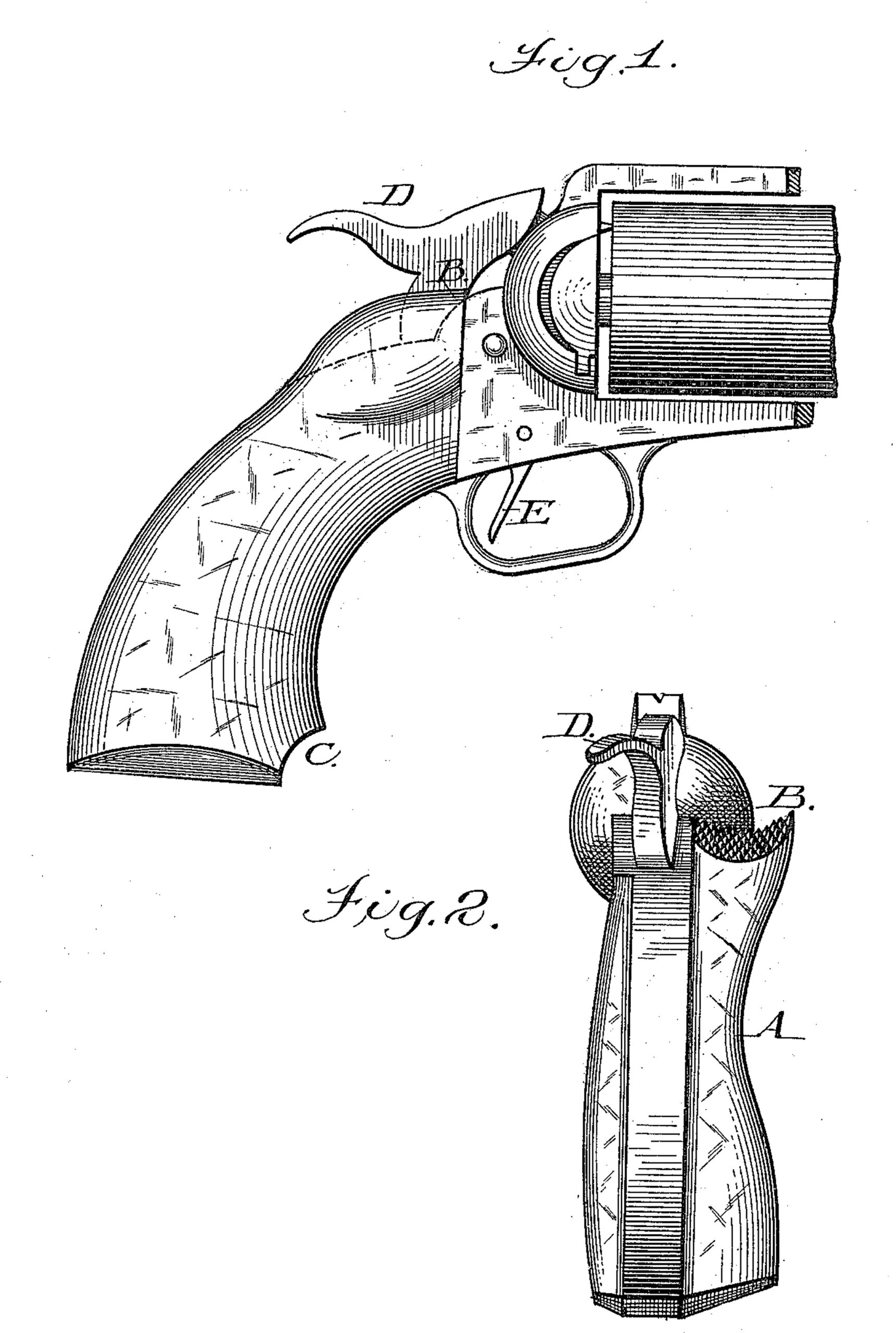US 297412
UNITED STATES PATENT OFFICE.
JOHN C. KELTON, OF SAN FRANCISCO, CALIFORNIA.
PISTOL-HANDLE.
SPECIFICATION forming part of Letters Patent No. 297,412, dated April 22, 1884.
Application filed August 31, 1883. (No model.)
To all whom it may concern:
Be it known that I, JOHN C. KELTON, of the city and county of San Francisco, State of California, have invented an Improved Pistol Handle; and I hereby declare the following to be a full, clear, and exact description thereof.
My invention relates to certain improvements in the construction of pistol-handles, so as to provide a more perfect grip for the hand, a means for extending the thumb along the handle in prolongation of the forearm, to produce a more rapid and correct alignment of the barrel on the object, and a recess to receive the little finger to steady the pistol and prevent the muzzle from dropping too low when the pistol is projected at the object to be fired at.
Referring to the accompanying drawings for a more complete explanation of my invention, Figure 1 is a right-side elevation. Fig. 2 is a rear view.
Owing to the unsteady support the hand in grasping the handle gives to a pistol, shooting with this weapon should be according to the snap method–that is, the eye should not be taken from the object to align the pistol, and no attempt should be made to look along the barrel. The best results are obtained when there is hardly a perceptible pause between quickly projecting the pistol and firing, the movement being similar to that in delivering a “blow” with the foil. In order to do this, and to give the greatest accuracy to the pistol projectile and limit to the utmost its lateral deviation, it is necessary that the thumb be extended along the stock and in line with the forearm. This cannot be done with the revolver-pistols as ordinarily constructed. I therefore form my pistol-handle in two (2) parts, the part A, to the right of the back strap, being curved to fit the hand, as shown in Fig. 2, and having nearly all the Wood in it, and having a groove or depression, B, into which the ball of the thumb will fit. This brings the axis of the stock slightly out of the plane of the axis of the barrel. At the front lower corner, where the screw of the back-strap is usually put, I form a recess, C, into which the little finger fits; and this prevents the pistol from dropping too much when projected in the act of firing. The comb D of the hammer is depressed nearly seventy degrees, so that when down it is about parallel with the barrel, and it is also broadened and bent about fifteen degrees to the left, so as not to interfere with the thumb when extended. It is also canted slightly to the right, so that the thumb may rest flat upon it in the act of cocking.
The trigger E is made broad and straight, and is inclined to the rear, so that it will be perpendicular to the force applied in pulling it.
Having thus described my invention, what I claim as new, and desire to secure by Letters Patent, is–
1. The improvement in pistol-handles, consisting of a stock attached to the back-strap, and formed with a curve upon one side to fit the hand, and made thicker at its curved side than at its opposite side, substantially as and for the purposes set forth.
2. In a pistol-handle, the stock enlarged upon one side and curved to fit the hand, and provided with the groove B, formed in its upper part at one side of the back-strap, and having the recess C in its lower end to receive the little finger of the operator’s hand, Substantially as and for the purposes herein set forth.
3. In a pistol-handle, the stock having the enlarged side portion, A, curved to fit the hand, and provided with the groove B in its upper end to receive the thumb of the operator’s hand, and also with the recess C in its lower end to receive the operator’s little finger, in combination with the broad flat trigger E, inclined backward at right angles to the line of applied force, substantially as described, and for the purpose specified.
4. In a pistol, the handle having the enlarged side portion, thumb-groove B, and finger-recess C, as shown, in combination with a hammer having the comb depressed, bent to the left, broadened, and canted to the right, substantially as herein shown and described. In witness whereof I hereunto set my hand.
JOHN C. KELTON.
Witnesses:
ALFRED PANSHO,
CHARLES MITTENBERGER.

